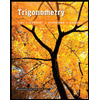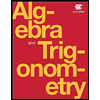3. A balloon is observed from two stations A and B at horizontal level, A being 1000m north of B. At a given instant the bearing of the balloon from A is 33.2° and its angle of elevation is 53.42°, while from B its bearing is 21.45. Calculate the height of the balloon. In the figure, a balloon is at P, and Q is directly below P. 0=33.2, e=21.45, a = 53.42 andd = 500m. same
3. A balloon is observed from two stations A and B at horizontal level, A being 1000m north of B. At a given instant the bearing of the balloon from A is 33.2° and its angle of elevation is 53.42°, while from B its bearing is 21.45. Calculate the height of the balloon. In the figure, a balloon is at P, and Q is directly below P. 0=33.2, e=21.45, a = 53.42 andd = 500m. same
Trigonometry (11th Edition)
11th Edition
ISBN:9780134217437
Author:Margaret L. Lial, John Hornsby, David I. Schneider, Callie Daniels
Publisher:Margaret L. Lial, John Hornsby, David I. Schneider, Callie Daniels
Chapter1: Trigonometric Functions
Section: Chapter Questions
Problem 1RE:
1. Give the measures of the complement and the supplement of an angle measuring 35°.
Related questions
Topic Video
Question

Transcribed Image Text:**Problem Statement:**
A balloon is observed from two stations A and B at the same horizontal level, with A being 1000m north of B. At a given instant, the bearing of the balloon from A is 33.2° and its angle of elevation is 53.42°, while from B, its bearing is 21.45°. Calculate the height of the balloon.
In the figure, a balloon is at P, and Q is directly below P. The values given are:
- φ (phi) = 33.2°
- θ (theta) = 21.45°
- α (alpha) = 53.42°
- d = 500m
**Diagram Explanation:**
The diagram illustrates a geometric situation for solving the problem:
- Points A and B are on the horizontal line, with A positioned north of B.
- Lines extending from A and B form angles φ and θ with the North direction, respectively.
- A line from B extends eastward, labeled d, representing the separation between A and B in the north-south direction.
- Labeled angles are:
- φ (33.2°) at A
- θ (21.45°) at B
- α (53.42°) at A, which is the angle of elevation to the balloon.
- Point P is the balloon’s position above the ground level.
- Point Q is positioned on the ground, directly below point P, vertically extending the line forming height h with P. The line segment connecting B and Q forms one side of the triangle, while PQ stands vertically indicating the height h of the balloon.
Expert Solution
This question has been solved!
Explore an expertly crafted, step-by-step solution for a thorough understanding of key concepts.
Step by step
Solved in 3 steps with 5 images

Knowledge Booster
Learn more about
Need a deep-dive on the concept behind this application? Look no further. Learn more about this topic, trigonometry and related others by exploring similar questions and additional content below.Recommended textbooks for you

Trigonometry (11th Edition)
Trigonometry
ISBN:
9780134217437
Author:
Margaret L. Lial, John Hornsby, David I. Schneider, Callie Daniels
Publisher:
PEARSON

Trigonometry (MindTap Course List)
Trigonometry
ISBN:
9781305652224
Author:
Charles P. McKeague, Mark D. Turner
Publisher:
Cengage Learning


Trigonometry (11th Edition)
Trigonometry
ISBN:
9780134217437
Author:
Margaret L. Lial, John Hornsby, David I. Schneider, Callie Daniels
Publisher:
PEARSON

Trigonometry (MindTap Course List)
Trigonometry
ISBN:
9781305652224
Author:
Charles P. McKeague, Mark D. Turner
Publisher:
Cengage Learning


Trigonometry (MindTap Course List)
Trigonometry
ISBN:
9781337278461
Author:
Ron Larson
Publisher:
Cengage Learning